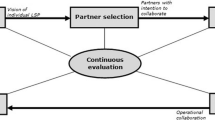Abstract
Collaborative logistics, logistics-based networks, focused logistics, and distributed adaptive logistics refer to innovative approaches to logistics planning/execution encompassing automated, adaptive technologies, and proactive human collaboration. Because these approaches are collaborative and distributed in nature, they create novel challenges for coordination and collaboration within socio-technical systems, which encompass the collaborative technologies, the people or machines engaged in collaboration, and the social context of collaboration and coordination. The present challenges need to be met by theoretical models incorporating multidisciplinary perspectives in the study of collaboration. The current paper introduces a collaboration framework which may inform the design and implementation of collaborative technologies and systems, to include distributed logistics teams, from a socio-technical perspective.

Similar content being viewed by others
Explore related subjects
Discover the latest articles, news and stories from top researchers in related subjects.References
Barnes J, Wiley V, Moore J, Ryer D (2004) Solving the aerial fleet refueling problem using group theoretical tabu search. Math Comput Model 39:617–640
Bartone P, Adler A, Vaitkus M (1998) Dimensions in psychological stress in peacekeeping operations. Mil Med 163:587–593
Becker-Beck U, Wintermantel M, Borg A (2005) Principles of regulating interaction in teams practicing face-to-face communication versus teams practicing computer-mediated communication. Small Group Res 36:499–536
Bell B, Kozlowski S (2002) A typology of virtual teams: implications for effective leadership. Group Organ Manag 27:14–49
Briggs R (2006) On theory-driven design and deployment of collaborative systems. Int J Hum Comput Stud 64:573–582
Crimiel D, Currie K (2005) Logistics executive agents: enhancing support to the joint warfighter. Air Force J Logistics 29:16–31
Dennis A, Valacich J (1993) Computer brainstorms: more heads are better than one. J Appl Psychol 78:531–537
Dirks K (1999) The effects of interpersonal trust on work group performance. J Appl Psychol 84:445–455
Gue K (2003) A dynamic distribution model for combat logistics. Comput Oper Res 30:367–381
Hertel G, Geister S, Konradt U (2005) Managing virtual teams: a review of the current empirical research. Hum Resour Manag Rev 15:69–95
Hinds P, Bailey D (2003) Out of sight, out of sync: understanding conflict in distributed teams. Organ Sci 14:615–632
Janis I, Mann L (1977) Decision making: a psychological analysis of conflict, choice, and commitment. Free Press, New York
Jarvenpaa S, Leidner D (1999) Communication and trust in global virtual teams. Organ Sci 10:791–815
Kasper-Fuehrer E, Ashkanasy N (2001) Communicating trustworthiness and building trust in interorganizational virtual organizations. J Manag 27:235–254
Kozlowski S, Bell B (2003) Work groups and teams in organizations. In: Borman W, Illgen D (eds) Handbook of psychology: industrial and organizational psychology. Wiley, New York, pp 333–376
McGrath J (1984) Groups: interaction and performance. Prentice-Hall, Englewood Cliffs
McQuay W (2005) Distributed collaborative environments for systems engineering. IEEE A&E Syst Mag August Edition 7–12
Moore D, Kutzberg T, Thompson L, Morris M (1999) Long and short routes to success in electronically mediated negotiation: group affiliations and good vibrations. Organ Behav Hum Decis Process 77:22–43
Mullen B, Cooper C (1994) The relation between group cohesiveness and performance: an integration. Psychol Bull 115:210–227
Mumford E (2000) A socio-technical approach to system design. Requirements Eng 5:125–133
O’Conner B, Fought S (2005) Airdrop and modularity. Air Force J Logistics 29:5–15
Office of Force Transformation (2004) Operational sense and respond logistics. Office of the Secretary of Defense
Straus S (1997) Technology, group process, and group outcomes: testing the connections in computer-mediated and face-to-face groups. Hum Comput Interact 12:227–266
Swartz S (2004) A multimethod approach to the combat air forces mix and deployment problem. Math Comput Model 39:773–797
Wainfan L, Davis P (2004) Challenges in virtual collaboration: videoconferencing, audioconferencing, and computer-mediated communications. Research report, RAND Corporation, California
Wicks A, Berman S, Jones T (1999) The structure of optimal trust: moral and strategic implications. Acad Manag Rev 29:99–116
Author information
Authors and Affiliations
Corresponding author
Rights and permissions
About this article
Cite this article
Ritter, J., Lyons, J.B. & Swindler, S.D. Large-scale coordination: developing a framework to evaluate socio-technical and collaborative issues. Cogn Tech Work 9, 33–38 (2007). https://doi.org/10.1007/s10111-006-0060-x
Received:
Accepted:
Published:
Issue Date:
DOI: https://doi.org/10.1007/s10111-006-0060-x




